The Salmon River, located in Idaho, meanders through central Idaho, spanning 425 miles (685 km). It flows through a sparsely inhabited, rugged watershed covering 14,000 square miles (36,000 km2). It has earned the moniker “The River of No Return” due to its swift and tumultuous rapids, posing a formidable challenge for upstream navigation. From where it starts at the Sawtooth Run to where it meets the Snake River, the river drops an astounding 7,000 feet (2,100 m).
The Salmon River flaunts a diverse and abundant fish community comprising salmon, trout, sturgeon, bass, and other species. Certain varieties of fish can grow to vast proportions, which makes them alluring to those who enjoy fishing or observing wildlife. This article will delve into the Salmon River’s top ten biggest fish species.
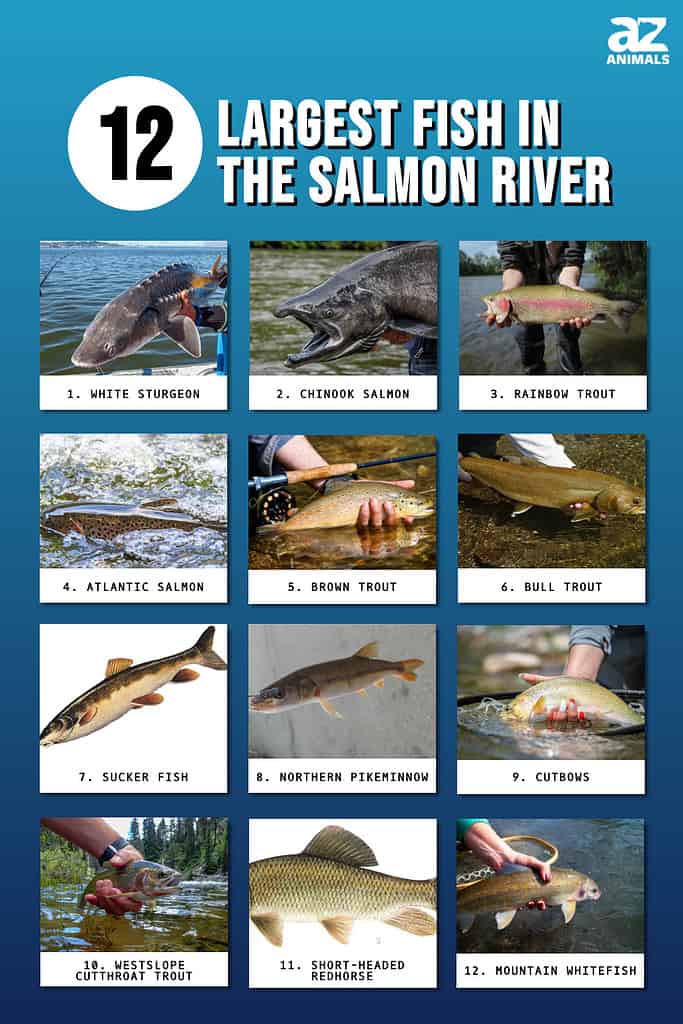
The 12 Largest Fish in the Salmon River
1. White Sturgeon (Acipenser transmontanus)

White sturgeon fishing catch and release.
©CSNafzger/Shutterstock.com
The white sturgeon, North America’s largest freshwater fish, has a remarkable lifespan exceeding one hundred years. These particular creatures are native to the Pacific Northwest and flourish abundantly in the rivers of Idaho, specifically the Snake, lower Salmon, and Kootenai Rivers. Sadly, the sturgeon population in the Kootenai River is currently endangered.
In contrast, the Idaho Fish and Game meticulously oversee the remaining populations’ survival, considering them recreational fish species.
Attaining lengths of up to 20 feet and weights exceeding 1,500 pounds, white sturgeon astound with their immense size. However, the majority of sturgeon captured by anglers are considerably smaller. Their dietary preferences encompass diverse fish and invertebrates. The spawning ritual of these fish occurs within fast-flowing water, typically over substrate consisting of rocks or gravel, between May and July.
White sturgeon, an ancient species, has undergone minimal evolution. Their skeletal structure is made of cartilage, possessing five rows of rigid plates known as scutes. Additionally, they have a lengthy snout with four barbels. They also have a spiral valve digestive system, a primitive trait shared with sharks, rays, and skates.
2. Chinook Salmon (Oncorhynchus tshawytscha)

A black streak along the gum line of the Chinook Salmon gives them the alternate name of blackmouth.
©Martin Rudlof Photography/Shutterstock.com
The Chinook salmon, also called king salmon, occupies the top spot among all salmon types in size. They engage in regular reproduction in the Salmon River, returning there following an extended period in the ocean. The Chinook salmon found in Idaho are classified into three groups: spring, summer, and fall, based on the time they begin their journey upstream.
Spring and summer Chinook reproduce in smaller streams connected to the Clearwater and Salmon rivers between August and September. Following their birth, young spring and summer Chinook reside in Idaho streams for approximately one year before embarking on their journey to the ocean in April and May.
They travel northward along the coastline toward the Gulf of Alaska. Fall Chinook, on the other hand, spawn directly in the primary section of the lower Salmon River and promptly make their way to the ocean once they emerge from the gravel.
Anglers are fascinated by Chinook salmon due to their impressive size, formidable resistance, and delicious taste. Moreover, these fish weigh between 12 and 20 pounds, although some exceeding 30 pounds are captured annually. The fishing period for Chinook salmon in the Salmon River spans from May to October, depending on the specific run and the designated season dates established by Idaho Fish and Game. The regulations and seasons differ depending on the location, and they are determined by factors such as:
- The quantity of Chinook returning to Idaho.
- The spawning requirements of individual hatcheries.
- The chance for different communities to partake in the harvest of these fish.
3. Rainbow Trout (Oncorhynchus mykiss)
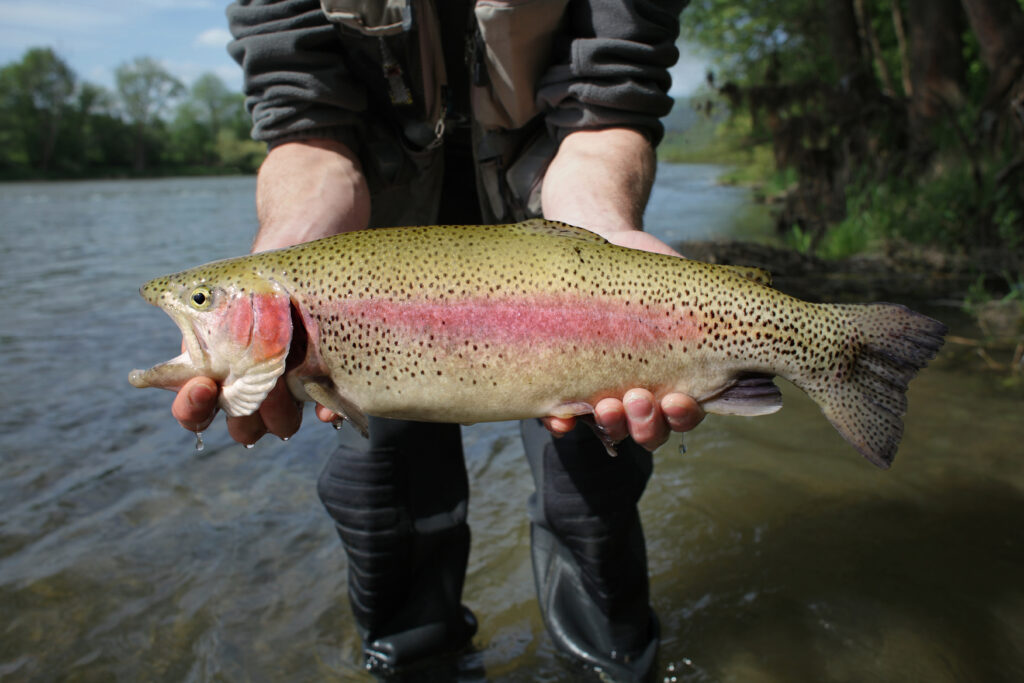
Anglers travel all over North America searching for large rainbow trout to catch.
©pictoplay/Shutterstock.com
The Rainbow trout is a well-known game fish in the Salmon River. These aquatic creatures are classified into two types under the salmonid family. One of them lives in fresh bodies of water like rivers and lakes. In contrast, the other variety, referred to as steelhead, embarks on extensive journeys from freshwater to the ocean solely for reproduction reasons.
The physical characteristics of rainbow trout include a lustrous silver exterior punctuated by dark patterns and a striking pink or red line that stretches along their body.
Rainbow trout can reach a length of 45 inches and a weight of 55 pounds. Nevertheless, the typical size of rainbow trout found in the Salmon River ranges from 12 to 16 inches in length and weighs between 1 and 2 pounds.
Several techniques can be used to capture them, including fly fishing, spinning, bait fishing, or trolling. The most promising locations for catching rainbow trout in the Salmon River are Stanley, Challis, Salmon, Riggins, and White Bird.
4. Atlantic Salmon (Salmo salar)
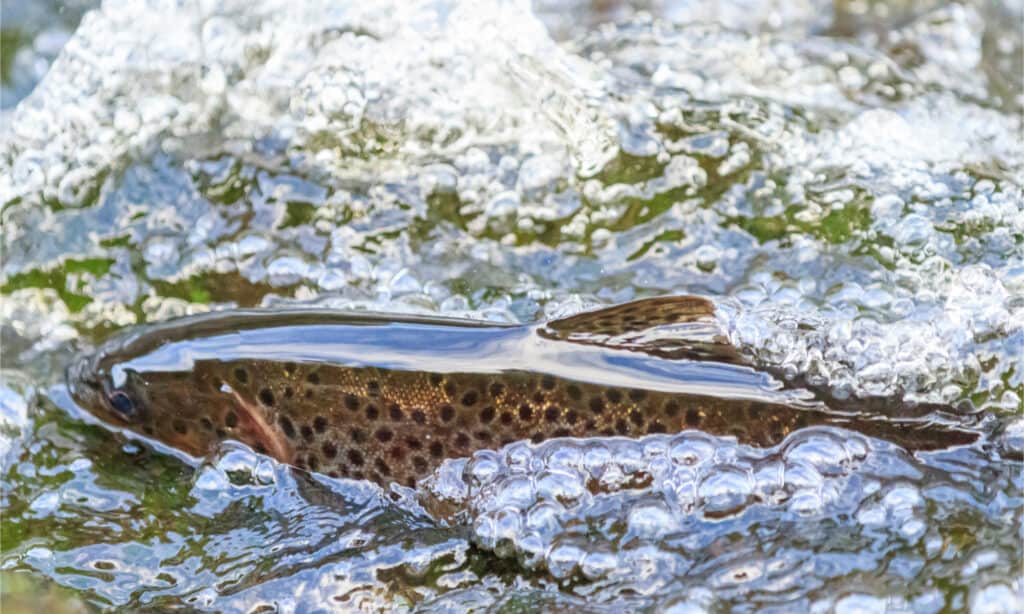
Male Atlantic salmon turn slightly green and have black spots when they’re ready to spawn
©Chanonry/Shutterstock.com
The Atlantic salmon, known as the “King of Fish,” lives in fresh and saltwater environments. Their life cycle begins in freshwater rivers, where they are born and nurtured as young fish. They then journey to the ocean, seeking nourishment, growth, and maturity in the saltwater habitat. Eventually, they return to their freshwater origins to reproduce. These fish, also known as 2SW, typically measure 28-30 inches long and weigh around 8-12 pounds.
In freshwater, young Atlantic salmon, called parr, sport a brown or bronze hue accompanied by distinct dark lines and spots in red and black. These markings serve a crucial purpose: helping them camouflage and defend against predators. However, when they return to the ocean, their vertical stripes disappear, and their appearance shifts to a shimmering silver, with dark backs and white bellies.
Upon returning to freshwater as adults to reproduce, they become shiny silver. Before mating in the fall, their skin changes back to a bronze hue. After reproduction, mature fish, called kelts, may darken further and are often called black salmon. When adults return to the ocean, their coloration switches back to silver, their primary counter-shaded color.
5. Brown Trout (Salmo trutta)
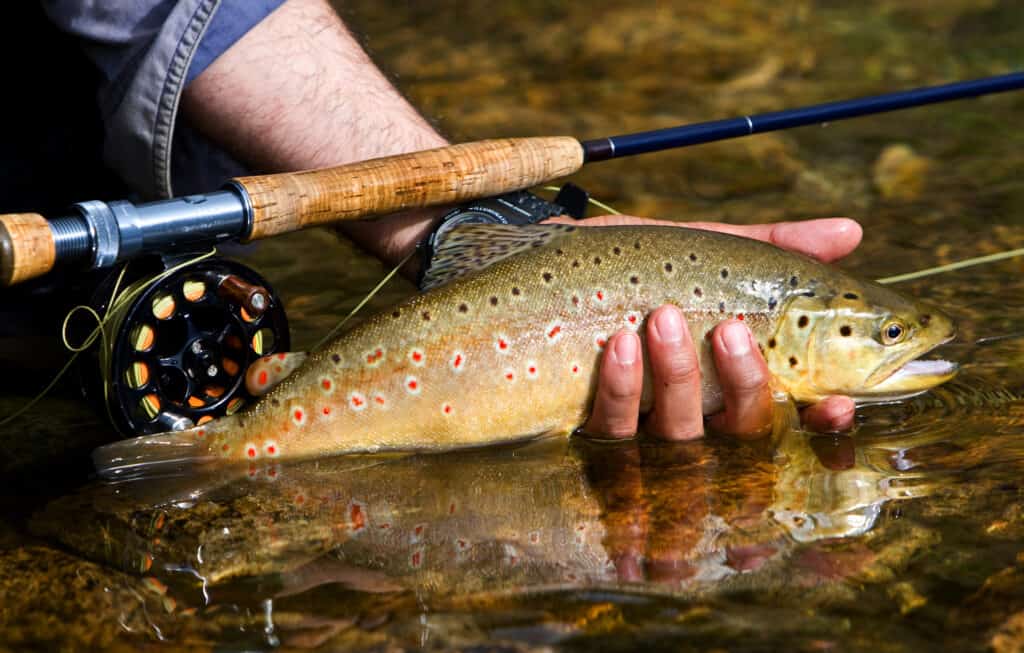
©iStock.com/MarceloDufflocqw
Adult brown trouts residing in lakes can grow larger on average because they expend less energy when locating food
The brown trout is a widely spread species known for its multi-colored sides. These sides feature black, brown, and red spots and iridescent cheeks. The size and weight of mature brown trout living in streams range from 15 to 22 inches and 1 to 5 pounds. Mature trout living in lakes can grow larger on average because they expend less energy when locating food, leading to them burning fewer calories as they fight against the water current. They can even weigh over 20 pounds in exceptional cases.
In autumn, brown trout that have reached reproductive maturity engage in breeding activities. The Browns usually embark on a journey upstream to their place of birth, where they deposit and fertilize large numbers of eggs per fish in specific spawning beds referred to as redds. After one to two months, the eggs transform into fry (infant fish) and fingerlings (adolescent fish).
These fingerlings evolve into adults within their first to third year and can breed and produce eggs. The exact duration of the growth process depends on their natural environment. Under normal conditions, their lifespan usually ranges from four to six years, but favorable circumstances may extend their life beyond ten years.
6. Bull Trout (Salvelinus confluentus)
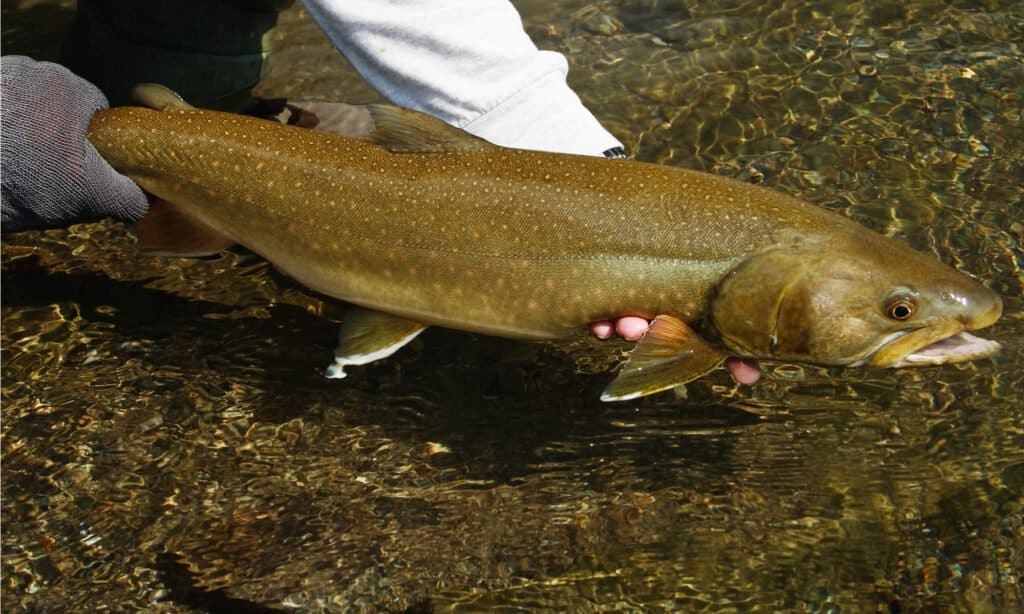
One can recognize the Bull Trout by its olive green hue with brown hues on the upper body and sides.
©Streamside Adventures/Shutterstock.com
The bull trout, known for being aggressive, once inhabited rivers of the Western region and were the top predators in the area’s indigenous fish communities. Regrettably, bull trout populations have declined over the past seven decades due to excessive fishing and their requirement for unspoiled habitats and pure, chilly waters.
Presently, the US Endangered Species Act classifies them as “Threatened.” One positive aspect is that the Middle Fork Salmon offers a suitable living environment for bull trout, positioning it among the top US streams for this particular fish species.
One can recognize the Bull Trout by its olive green hue with brown hues on the upper body and sides. Additionally, the fish flaunts a combination of tiny spots ranging from pale yellow to crimson, arranged over a darker body that gradually transitions to a white shade on its belly. The yellow spots commonly adorn the top portion of the body, whereas the red or orange spots are usually found on the sides. Their fins frequently display white stripes at their tips.
7. Sucker Fish (Catostomus)
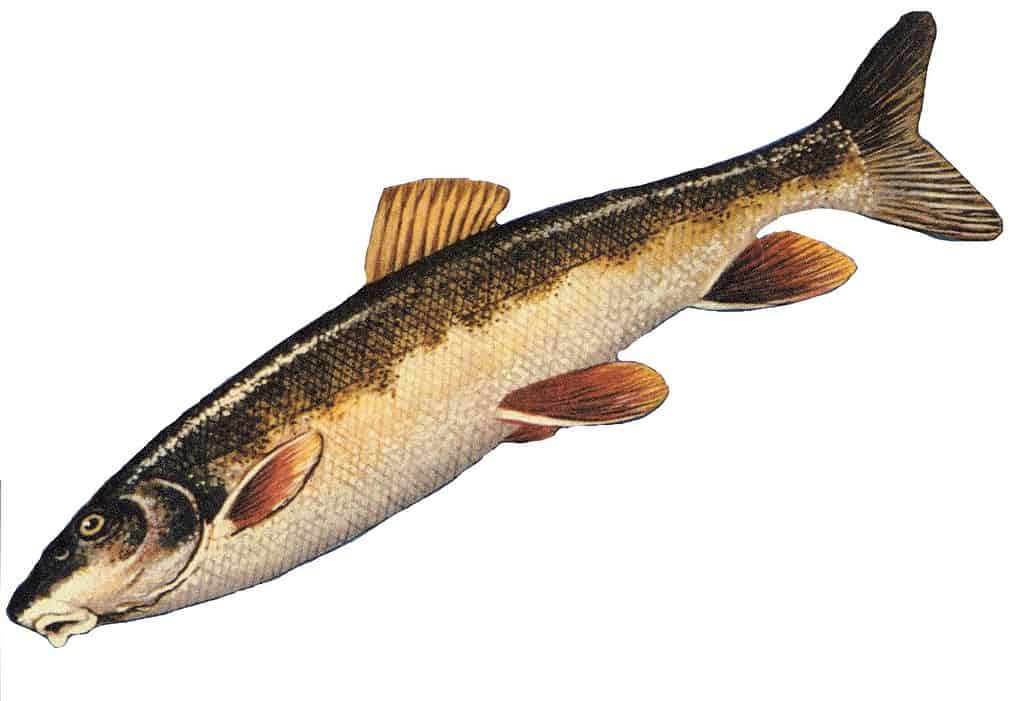
Longnose sucker. Catostomus catostomus.
©NOAA Great Lakes Environmental Research Laboratory/Public Domain – License
Many fishermen often overlook the Sucker fish, similar to Whitefish, as a popular catch. Despite their unattractive, dull appearances and downward-facing mouths, they are unlikely to emerge victorious in beauty pageants. However, they share a common characteristic with Whitefish as they are a vital and indigenous component of the fish ecosystem in the Salmon River.
Idaho is home to eight kinds of sucker fish, with the Bridgelip, Mountain, and Largescale varieties being the most visible in the Middle Fork region specifically.
The dorsal and lateral areas can be either bronze, brown, or gray, which blends into a lighter hue on the ventral region, such as white, cream, or pale yellow.
Sucker fish have the potential to reach tremendous proportions. Unfortunately, anglers hardly consider these fish a game catch, mainly due to their perceived unattractiveness and lack of resistance. Harvesting them in Idaho is unlawful as they are under protection.
8. Northern Pikeminnow (Ptychocheilus oregonensis)
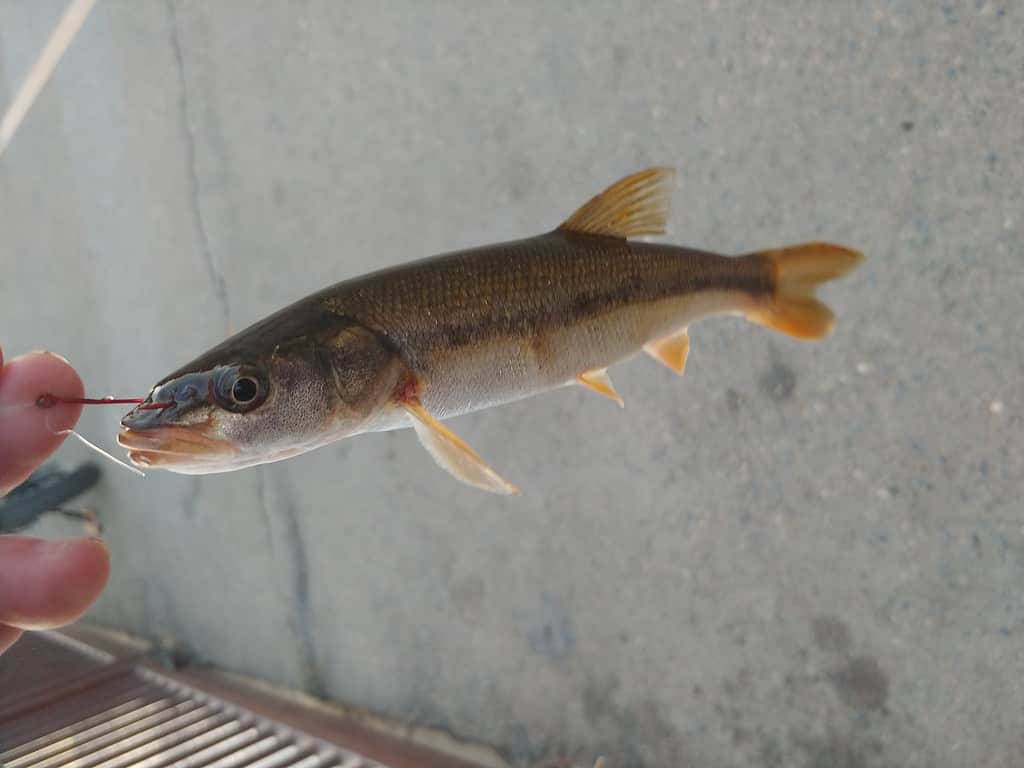
Known for its remarkable hunting skills, the Northern Pikeminnow possesses a keen sense of sight and lightning-fast reflexes, making it a top predator in its aquatic realm
©iStock.com/grimxlink
Despite being capable of reaching lengths up to 25 inches (with the largest recorded one weighing around 7 lbs. ), it’s not common to observe them attaining substantial sizes in The Middle Fork. As a result, numerous states have implemented financial incentives to motivate fishermen to catch Pikeminnows, with the primary aim of safeguarding salmon populations.
The mouth is sizable, and the tail fin has a prominent forked shape. Spots are not present on fins. The Middle Fork area doesn’t typically prioritize catching Pikeminnow during fishing excursions. Many fly patterns, designed to resemble small baitfish, take inspiration from the Pikeminnow’s body shape and coloring.
9. Cutbows (Oncorhynchus clarkii × O. mykiss)
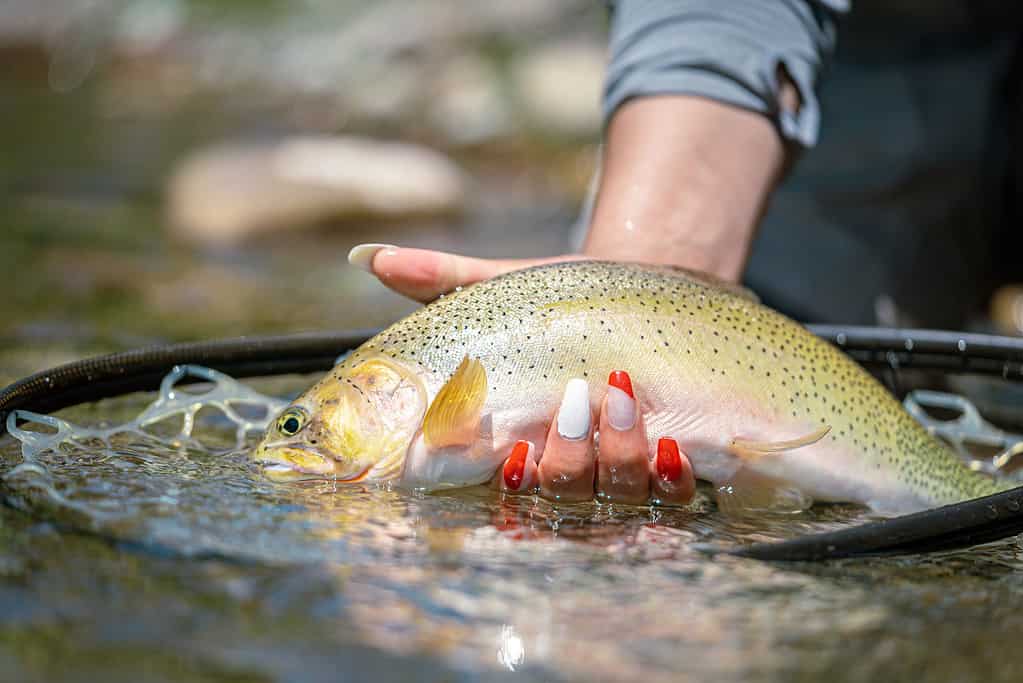
The cutbow is a mixture of the rainbow and cutthroat trout (pictured above)
©iStock.com/Wirestock
A cutbow is a mix of rainbow and cutthroat trout. These hybrids occur naturally in spots where the homes of these two species overlap. Identifying Cutbows can be difficult, but their unique traits — a mixture of the rainbow and cutthroat trout features — are key indicators. Frequently, these fish will exhibit the traditional sharp orange mark on their jaws and a more uniform distribution of spots in varying shades of red throughout their sides, resembling the colors of a rainbow.
Cutbows typically have white tips on their fins that don’t exist in pure cutthroat. The Middle Fork River has witnessed successive generations engaging in crossbreeding due to the fertility of interbred cutbows. Feeding tendencies, ancestry, and fishing patterns resemble those of cutthroat and rainbow trout.
10. Westslope Cutthroat Trout (Oncorhynchus clarkii lewis)
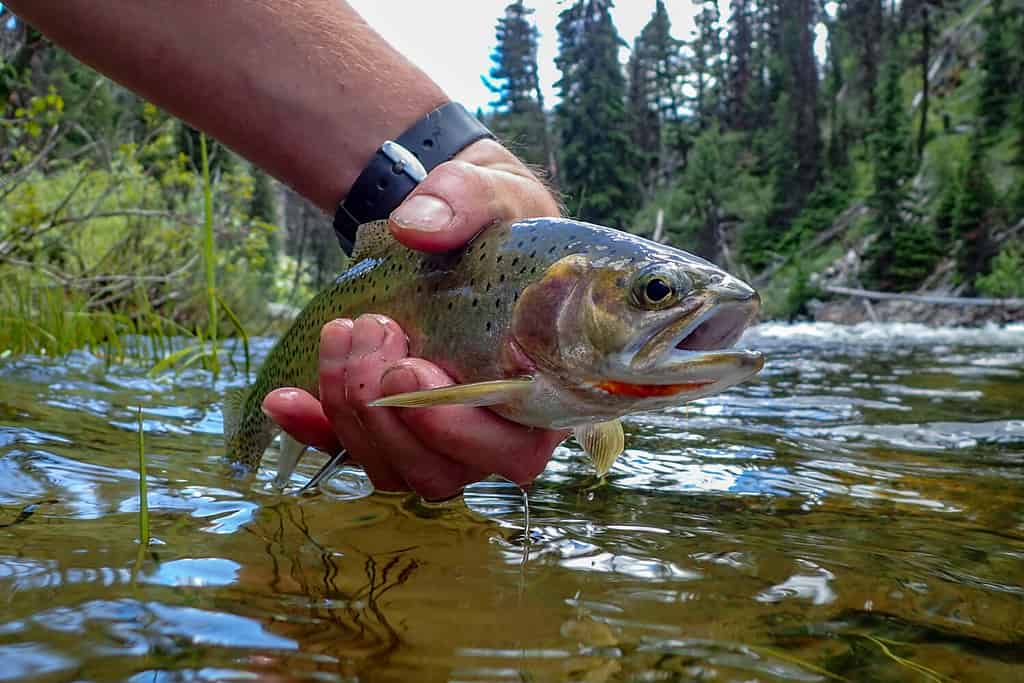
©CSNafzger/Shutterstock.com
One can easily identify the cutthroat based on reddish-orange marks under the lower jaw
Identifying the Westslope Cutthroat Trout from other subspecies of cutthroat can be challenging due to multiple varieties. However, one distinguishing characteristic is that the Westslope Cutthroat Trout typically has more small spots near its tail. The fish are indigenous to the alluvial or freestone waterways that commonly flow into rivers in the Pacific region.
According to archaeological findings, it seems probable that the cutthroat trout were among the initial types of trout to either migrate to or develop in Idaho. Adding to the complexity, a new kind of cutthroat fish known as the Yellowstone Cutthroat thrives in certain bodies of water in the Frank Church Wilderness.
One can easily identify the cutthroat based on a distinctive trait — the presence of reddish-orange marks under the lower jaw. The color of the body may differ from steel gray to olive green, and typically it closely corresponds to the fish’s ideal environment. The flanks can exhibit either a yellow or brown hue, while the underbelly may display traces of red or pink. A denser grouping of spots commonly characterizes the tail area of the fish.
11. Short-Headed Redhorse (Moxostoma macrolepidotum)

For many years, the geographical distribution of the silver redhorse (pictured above) and the shorthead redhorse has made them significant water quality indicators
©Ellen Edmonson and Hugh Chrisp, Public domain, via Wikimedia Commons – License
The short-headed redhorse is the most common and dominant variety of sucker fish. It is among the most colorful as well. The fins display an array of hues, with some having vibrant orange tones and others a deep red shade. The sides manifest diverse colors, such as silver, gold, or bronze. Their abdomen ranges from a pale yellow hue to a milky tint.
The fins do not have stiff spines, and teeth are absent. The shorthead fish is popular for its remarkably small head, approximately 17-19% of its total body length.
For many years, the geographical distribution of the silver redhorse and the shorthead redhorse has made them significant water quality indicators. The demand for catching this fish as a leisure activity has been increasing. Many avid anglers are now in pursuit of this unique species of fish. Although the shorthead’s meat possesses a savory and sweet flavor, it contains several tiny bones.
12. Mountain Whitefish (Prosopium williamsoni)
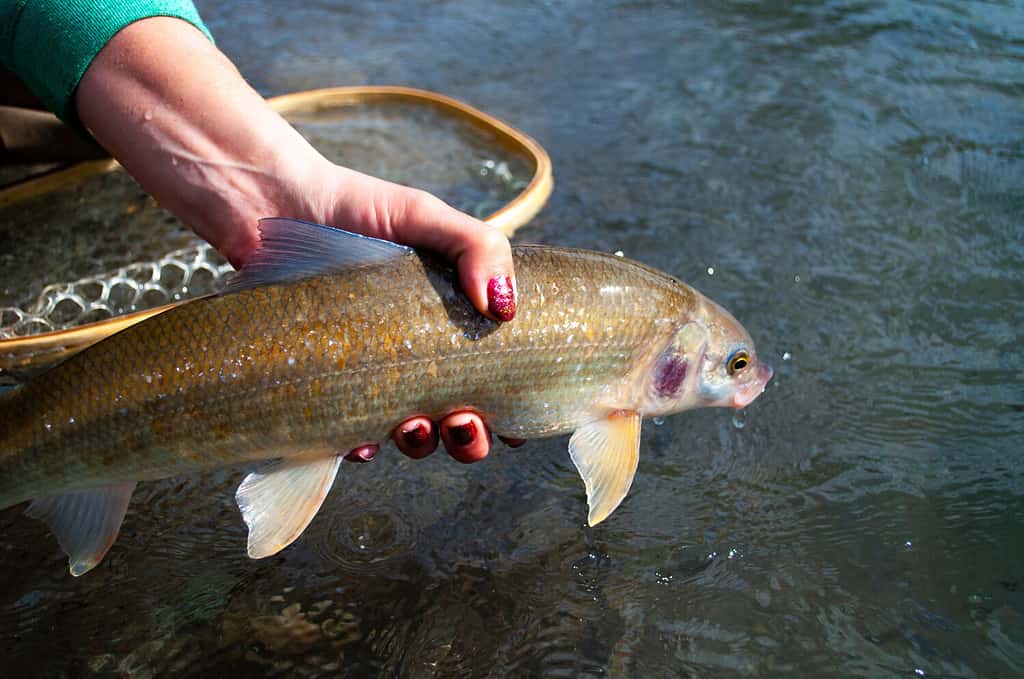
©Jennifer de Graaf/Shutterstock.com
Idaho is the natural habitat of the Mountain Whitefish
Some anglers have differing opinions about catching this particular fish. Some favor Whitefish due to their unique characteristics and ability to reach significant dimensions. Furthermore, there are those who criticize the Whitefish fish species due to its smallmouth, slimy texture, and perceived absence of resistance during fishing. Regardless of the scenario, the presence of Mountain Whitefish in the Salmon River ecosystem is significant and integral since they are native to the area.
Idaho is the natural habitat of the Mountain Whitefish. Their adaptability allows them to inhabit diverse habitats, from Alaska to the upper region of the Missouri River. They typically opt for chilly, crystal-clear water and often scavenge near the bottom.
Typically, the Mountain Whitefish display a bluish-gray color on their back. Their sides are silvery, and their stomach often appears pale white. Their unique characteristic is their small, downward-curved mouth, adapted for consuming insect larvae and other invertebrates on the riverbed.
Key Takeaways From The Largest Fish In The Salmon River
The Salmon River’s ecosystem in Idaho is noteworthy for its remarkable variety of fish species. The river boasts an impressive array of massive freshwater fish, ranging from the gigantic white sturgeon to the vibrantly hued Chinook salmon. The Salmon River attracts fishing enthusiasts and nature lovers who want to grasp the opportunity to observe and capture these magnificent fish.
The rapid and challenging currents of the river contribute to the attraction of fishing in this vicinity. Although certain fish species, such as the white sturgeon and bull trout, are at risk of extinction, certain initiatives are in place to safeguard and maintain their numbers. The Salmon River remains a refuge for fishing enthusiasts and demonstrates the exquisite beauty of Idaho’s water systems.
Summary of The 12 Largest Fish in the Salmon River
| Rank | Fish |
|---|---|
| 1 | White Sturgeon |
| 2 | Chinook Salmon |
| 3 | Rainbow Trout |
| 4 | Atlantic Salmon |
| 5 | Brown Trout |
| 6 | Bull Trout |
| 7 | Sucker Fish |
| 8 | Northern Pikeminnow |
| 9 | Cutbows |
| 10 | Westslope Cutthroat Trout |
| 11 | Short-Headed Redhorse |
| 12 | Mountain Whitefish |
The photo featured at the top of this post is © Intermountain Forest Service, USDA Region 4 Photography / Public Domain – License / Original
Thank you for reading! Have some feedback for us? Contact the AZ Animals editorial team.






